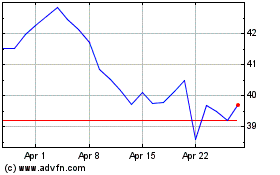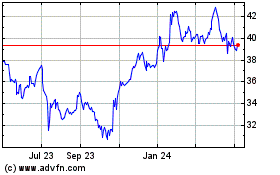By Thomas Gryta And Ryan Knutson
A battle is brewing among tech giants over the future of Wi-Fi,
the ubiquitous and unregulated wireless connections at the core of
the mobile Internet.
Verizon Communications Inc. and T-Mobile US Inc. are preparing
to broadcast cellular signals over some of the same free airwaves
currently used by Wi-Fi networks. The wireless carriers plan to
begin rolling out the technology next year.
That worries startups like Republic Wireless as well as
companies like Google Inc. and Cablevision Systems Corp. that have
built services that rely on Wi-Fi networks. They argue Verizon's
and T-Mobile's signals could take up space Wi-Fi services normally
use and crowd them out. Wi-Fi networks--in homes, offices, airports
and coffee shops--already carry more than half of mobile data usage
globally.
Google officials wrote a letter in June to the Federal
Communications Commission urging caution. Google said the new
technology is "particularly worrisome" because wireless carriers
"may view some Wi-Fi providers, such as cable companies offering
Wi-Fi hot spots to their customers, as competitors."
Verizon and T-Mobile say the expansion is needed to manage the
surging consumer demand to stream videos and surf the Web on
smartphones and tablet computers. The carriers say using the
unlicensed airwaves is an inexpensive way to quickly increase
capacity and speed on their congested networks. They say the new
technology, called LTE-U, can coexist with Wi-Fi harmlessly.
"Wi-Fi is very important to us because it's very important to
our customers," said Patrick Welsh, director of federal government
affairs at Verizon. "Every test that we've done shows that LTE-U is
as good of a neighbor to Wi-Fi as Wi-Fi is to itself."
The debate has turned political. Late last month, six Democratic
senators wrote a letter to FCC Chairman Tom Wheeler expressing
concern of possible Wi-Fi harm and asking him to intervene. The FCC
has opened a proceeding to study the issue. The supporters of LTE-U
insist there is no need for rules or any intervention, and point
out that the airwaves Wi-Fi uses aren't limited to a single
technology. A senior FCC official said the agency is monitoring the
situation and doesn't expect to take any action at this time, but
is considering the submitted comments.
The existing rules for using unlicensed spectrum are light. They
only limit transmission power and ensure that signals don't bleed
into other channels.
The new LTE-U technology is a modified version of the
fourth-generation cellular standard that carriers use to route
phone calls and data on their networks. Wi-Fi operates over
unlicensed airwaves, checking for an open channel before
broadcasting. LTE-U checks, but will broadcast on the least
congested channel rather than wait for an open one. That means that
Wi-Fi signals could get shoved around, critics say, and reduce the
speed and quality of their connection.
Earlier this month, Julius Knapp, the head of the FCC's Office
of Engineering and Technology, wrote a letter to Verizon and other
backers of LTE-U asking technical questions about the technology,
including why it would be able to transmit on an already occupied
channel.
Verizon created a group called the LTE-U Forum in April 2014
along with equipment vendors such as Qualcomm Inc. and Ericsson to
develop the technology. That process is taking place alongside
efforts at international bodies to create standards for similar
technology. Unlike LTE-U, the global standards are expected to have
a "listen before talk" mechanism similar to Wi-Fi.
Verizon and T-Mobile say they aren't going to wait for the
international groups to finish setting those standards. Both
carriers say they plan to begin adding LTE-U radios to their
networks next year, potentially giving them a two-year lead over
operators that wait.
"We are going way, way, way beyond what anyone could require in
rules to make sure it will work well," said Dean Brenner,
Qualcomm's senior vice president for government affairs.
AT&T Inc., which operates a large network of Wi-Fi hot
spots, has urged the FCC to not set new regulations around the use
of unlicensed airwaves but hasn't set any plans to launch LTE-U. A
spokesman for the company said it is "supportive of LTE use of
unlicensed bands as long as it can properly coexist with
Wi-Fi."
The debate over the new technology comes as the price for
licensed airwaves is rising. The FCC's last auction raised more
than $40 billion, including $18.2 billion from AT&T and $10.4
billion from Verizon. An auction set for 2016 might raise more. The
cost makes it hard both for new businesses to enter the market and
established ones to maintain their networks. Verizon said earlier
this year that airwaves had become so expensive it would look to
new technologies to improve network speeds.
Meanwhile, consumer reliance on Wi-Fi has grown significantly.
Wi-Fi first gained popularity in the early 2000s after it became
standard on Apple Inc. computers, allowing users to access the
Internet without plugging their computers into a cable. Then,
wireless carriers encouraged customers to log on to Wi-Fi with
their smartphones as a way to ease network congestion. Consumers
got used to the typically faster Wi-Fi speeds--and importantly,
their lack of data caps--helping fuel Wi-Fi's growth.
Upstarts like Republic Wireless and Scratch Wireless Inc. offer
cheap cellphone service that runs primarily over Wi-Fi signals and
only falls back to cellular networks when Wi-Fi is out of range.
Firms like Google and Cablevision are also using Wi-Fi to offer
similar services. All of the efforts are nascent, and have tiny
subscriber bases compared with the more than 100 million
subscribers on Verizon.
Wi-Fi is the only alternative network to wireless carriers, said
David Morken, co-founder and chief executive of Republic Wireless,
a division of Bandwidth.com Inc. "It is in their best interest, and
importantly perhaps strategic long-term interest, to marginalize
Wi-Fi as much as possible as an alternative open, creative
ecosystem," Mr. Morken said of the carriers.
Verizon and other wireless carriers reject the idea they intend
to harm Wi-Fi. They say their intentions are only to improve the
wireless experience for existing customers. Ericsson says the
addition of LTE-U could improve network speed by 150 megabits per
second, a considerable bump over current cellular networks.
Harold Feld, senior vice president at Public Knowledge, a
consumer-advocacy group, said Wi-Fi is too important to wait and
see how LTE-U affects it. Even if the impact is minimal, allowing
LTE-U to proliferate could give carriers the ability to slowly
strangle Wi-Fi, he said. "You don't have to kill it to make a
really potent weapon against the competing services," he said.
Write to Ryan Knutson at ryan.knutson@wsj.com
Subscribe to WSJ: http://online.wsj.com?mod=djnwires
(END) Dow Jones Newswires
August 25, 2015 19:16 ET (23:16 GMT)
Copyright (c) 2015 Dow Jones & Company, Inc.
Verizon Communications (NYSE:VZ)
Historical Stock Chart
From Mar 2024 to Apr 2024

Verizon Communications (NYSE:VZ)
Historical Stock Chart
From Apr 2023 to Apr 2024
